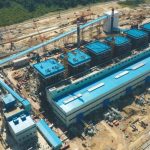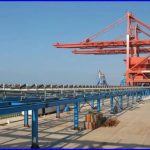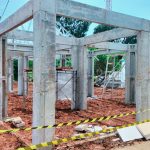Liga Asuransi – Dear readers, how are you? Let’s continue our discussion around the construction industry. After previously we discussed a lot about the physical risks of a project, this time we will share important information on how contractors use the project budget efficiently.
As insurance brokers, we pay great attention to the cost efficiency of the project as it relates to the success of our client’s project.
In part 7 of what we discussed in this paper; you are going to read about the importance of risk management in reducing project costs.
This article is taken from various sources on the internet. The links are included in the last part of this article.
If you are interested in this article, please share it with your colleagues so that they also understand
As we know that all contractors aim for their projects to be successful and to meet client expectations as well as their internal objectives.
But what is the reality on the ground? In a report, only 57% of the projects finished within their initial budgets, with the others exceeding the target they had set for themselves.
Understanding what project cost management is and how to be effective at it can be beneficial for Contractors to stay on course.
What is Project Cost Management?
Project cost management is the process of estimating, budgeting, and controlling costs throughout the project life cycle, to keep expenditures within the approved budget.
For a project to be called successful, it’s necessary that
- it delivers on the requirements and scope
- its execution quality is of a high standard
- it’s completed within schedule and
- it’s completed within budget.
Why is Project Cost Management Important?
The importance of cost management is easy to understand. To take a simple, real-life example, if you decide to build an apartment or house, the first thing to do is set the budget.
The budget will determine critical decision points such as: which designer to hire—a high-end one who will construct and deliver the project end-to-end, or someone who can help with a few elements and be able to work for a smaller budget? How many stories should the house have? What quality of materials should be used?
By implementing efficient cost management practices, project managers can:
- Control scope creep due to transparencies established with the customer
- Generate data to benchmark for future projects and track long-term cost trends
- Maintain expected margin, increase ROI, and avoid losing money on the project
- Set clear expectations with stakeholders
- Track progress and respond with corrective action at a quick pace
14 Steps in Project Cost Management
- Cost Historical Data
Consider historical data—past schedules and effort—before determining sub-tasks and the corresponding resources.
Take feedback from SMEs and team members—a collaborative approach works well, especially in projects that do not have past data to use.
- Cost Estimation
Cost estimation is the process of quantifying the costs associated with all the resources required to execute the project. To perform cost calculations, we need the following information:
- Resource requirements (output from the previous step)
Price of each resource (e.g., staffing cost per hour, vendor hiring costs, server procurement costs, material rates per unit, etc.)
- Insight into the company’s financial health and reporting structures
- List of assumptions
- Past project costs and industry benchmarks if any
- Potential risks
- The duration that each resource is required
Estimation is arguably the most difficult of the steps involved in cost management as accuracy is the key here. Also, project managers must consider factors such as fixed and variable costs, overheads, inflation, and the time value of money.
The greater the deviation between estimation and actual costs, the less likely it is for a project to succeed. However, there are many estimation models to choose from.
Analogous estimation is a good choice if you have plenty of historical cost data from similar projects. Some Contractors prefer mathematical approaches such as parametric modeling or program evaluation and review techniques (PERT).
Then there is the choice between employing a top-down versus bottom-up approach. Top-down typically works when past costing data are available.
- Cost Estimation as a Decision Enabler
It’s useful to remember that cost estimation is done at the planning stage and, therefore, everything is not yet set in stone. In many cases, project teams come up with multiple solutions for a project, and cost estimation helps them decide which way to go.
There are many costing methodologies, such as activity-based costing, job costing, and lifecycle costing that help perform this comparative analysis.
Sometimes the estimation process also allows teams to evaluate and reduce costs. Value engineering, for example, helps to gain the optimal value from a project while bringing costs down.
- Cost Budgeting
Cost budgeting can be viewed as part of estimation or as a separate process. Budgeting is the process of allocating costs to a certain chunk of the project, such as individual tasks or modules, for a specific period. Budgets include contingency reserves allocated to manage unexpected costs.
Budgeting creates a cost baseline against which we can continue to measure and evaluate the project cost performance.
If not for the budget, the total estimated cost would remain an abstract figure, and it would be difficult to measure midway. Evaluation of project performance allows assessing how much budget needs to be released for future phases of the project.
Another reason to firm up budgets is that Contractors often rely on expected future cash flows for their funding. During the initial phases, the project manager has a limited financial pool and must set targets accordingly.
- Cost Control
Cost control is the process of measuring cost variances from the baseline and taking appropriate action, such as increasing the budget allocated or reducing the scope of work, to correct that gap. Cost control is a continuous process done throughout the project lifecycle.
Along with the cost baseline, the cost management plan is an essential input for cost control. This plan contains details such as how project performance will be measured, what is the threshold for deviations, what actions will be done if the threshold is breached, and the list of people and roles who have the executive authority to make decisions.
Earned value management (EVM) is one of the most popular approaches to measuring cost performance. Let’s take an example.
While dealing with hundreds of tasks in huge projects, cost control can provide the level of transparency that decision-makers require to respond quickly to the situation.
- Identify risks and uncertainties early in the project
Not addressing emerging risks at the correct time, may lead to adverse implications at the later stage of the project and eventually affect the overall outcome.
Thus, it is better to weigh risks and uncertainties early enough and save a significant amount of money originating from downtime on the construction sites.
At fundamental levels, uncertainties and risks are two different things. Uncertainties pertain to events while risks are fallouts of events from probability and are dictated by statistical probability.
Though both are different and have different implications, anticipating them through Virtual Design Construction (VDC) on the platform mitigates risks and keeps projects within budgets.
- Avoid reworks
Reworks are most definitely costly and are better avoided than dealt with in later stages. Costly not only in financial terms but also in terms of creating friction between different stakeholders and the contractor which ultimately tends to damage a construction firm’s reputation.
Preventing reworks is the most effective cost reduction solution.
- Have an effective communication mechanism
Large construction projects involve the multidisciplinary participation of professionals and manual laborers. Their communication lines should be open and transparent enough to make the right decisions required for efficient cost planning.
Along with inter-team communication, long-term relationships between contractors and suppliers prove advantageous when costs are at stake.
This is a repetitive business generating element for suppliers who are always up for price negotiations and adjust to contractors’ flexibility in terms of building product requirements for the construction project. Such a development in relationships continues even in tight industry phases.
- Allocate competent resources during the project initiation phase
Identifying and assigning the right resources during the project initiation phase helps deliver projects within time and budget. It also helps avoid allocating under or over-skilled resources to various project tasks.
Assigning under-skilled resources will cause delivery delays and compromise quality. On the other hand, if a resource manager allocates over skilled resources, their high costs will cause budget overrun.
At the same time, one must allocate the best available best fit instead of the first visible first-fit resources. Distributing high-skilled resources across all projects instead of assigning them to a high priority one further helps reduce costs.
- Cost-effective global resources across matrix boundaries
If local resources for a particular skill set are not available, a multi-location policy helps leverage global resources from low-cost locations to do the job.
It helps in reducing project resource costs significantly without compromising the quality. Replacing high skilled resources with low-cost generic ones with similar skill sets helps control the budget. Instead, the high skilled resources can provide mentoring and training to upskill other junior resources.
Sometimes it becomes very difficult to do succession planning for a critical multi-skilled resource. If the role of such an employee needs to be distributed to multiple resources, the cost can go up substantially.
- Track forecasted vs. actual spending to control project costs
Tracking project financials helps to avoid budget overruns. Project managers can control costs by periodically tracking and comparing the actual spending against the estimated budget. If there is a variance, necessary corrective measures can mitigate project risks ahead of time.
Comparing the forecasted vs. actual spending helps in improving future estimations and aligns with reality.
Certain measures such as resource leveling or resource smoothing can be applied in case a project faces a budget-related challenge. In the first case, the project timeline can be extended to accommodate the availability of resources.
- Save last-minute hiring costs for the pipeline projects
Visibility into pipeline projects in the opportunity or approval stage enables project managers to plan for resource requirements ahead of time.
It helps deliver projects within time and budget to achieve higher client satisfaction. Resource capacity planning tools perform a gap analysis to identify excesses and shortages of resources ahead of time.
Accordingly, resource managers can use appropriate resourcing treatments to fulfill resource requirements. They can also effectively plan to make the existing bench resources billable.
These treatments include adjusting timelines or selling excess capacity for excesses and retraining or using a contingent workforce for shortages.
- Boost productivity with a job rotation strategy
Low employee productivity dampens the project quality, spikes costs, and eventually results in unplanned attrition.
Allocating employees to project tasks without considering their skills and interests can lead to low productivity. Monotonous and limited work opportunities can render a feeling of boredom and career stagnation to employees.
Resource managers can boost employee productivity by implementing a job rotation strategy. Exposing employees to different project tasks provides them ample skill-building opportunities.
Why do you need an insurance broker for your Project insurance?
Insurance brokers are insurance experts who understand well the ins and outs of insurance coverage. They understand the insurance coverage you need.
They design insurance programs and negotiate them with several insurance companies that can provide the best guarantees.
In addition, insurance brokers also negotiate the most efficient premium rates without reducing the guaranteed benefits provided by the insurance policy.
One of the insurance brokers companies experienced in the field of construction insurance in Indonesia is L&G Insurance Broker.
For all your company’s insurance needs contact L&G right now!
Sources:
- https://www.saviom.com/blog/5-ways-reduce-project-management-costs/
- https://www.ecosys.net/knowledge/project-cost-management/
- https://constructionreviewonline.com/management/4-ways-make-construction-project-cost-effective/
—
Looking for Insurance Products? Don’t Waste Your Time and Contact Us Right Now
L&G HOTLINE 24 HOURS: 0811-8507-773 (Call – Whatsapp – SMS)
website: lngrisk.co.id
E-mail: customer.support@lngrisk.co.id
—

















